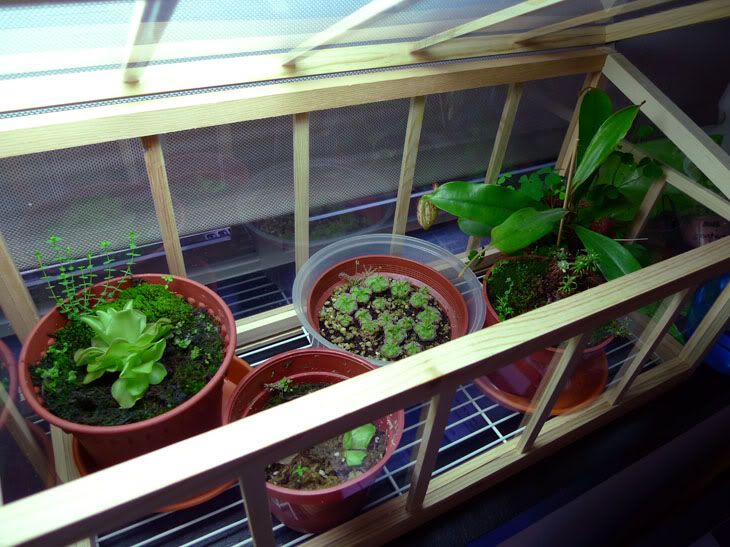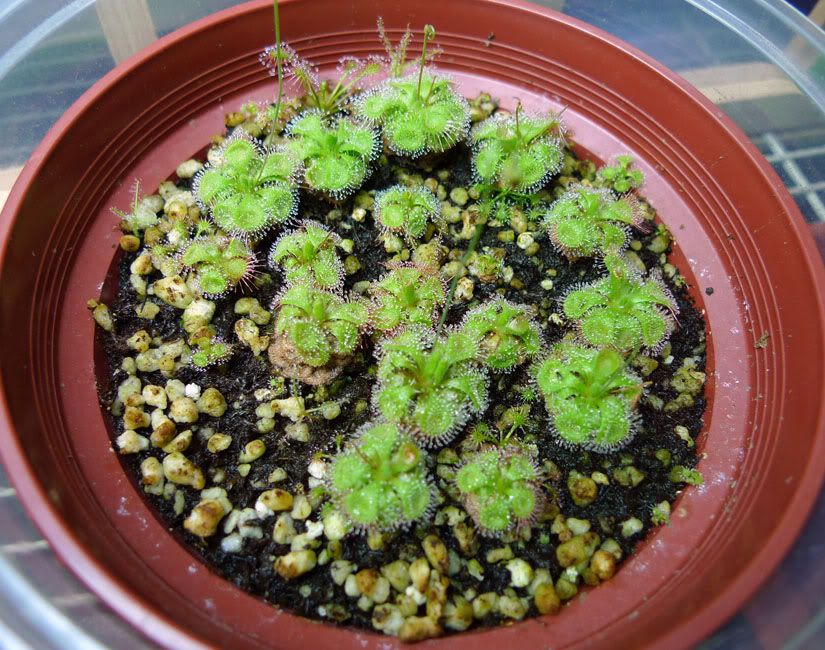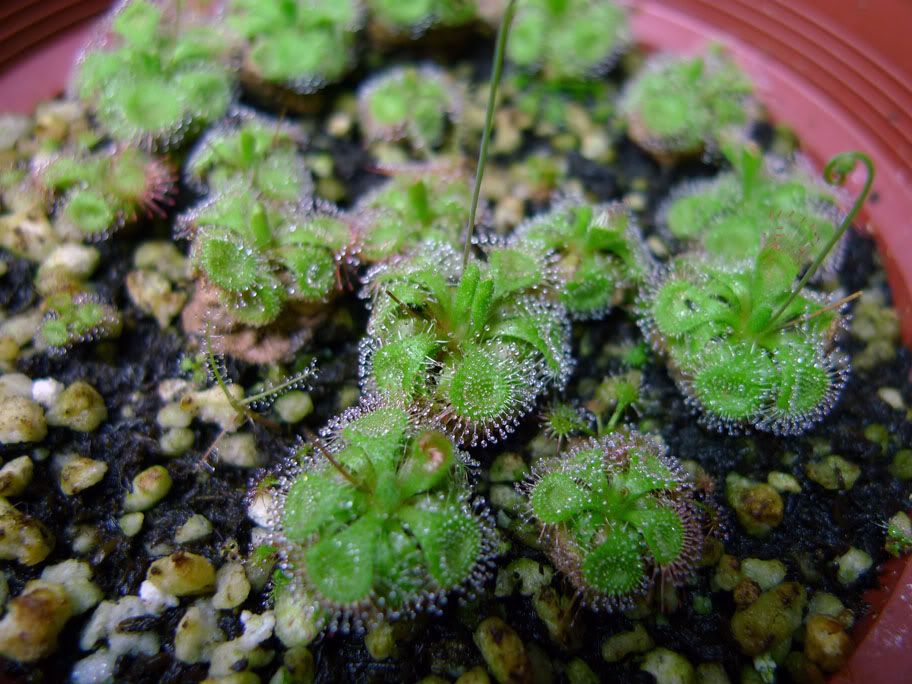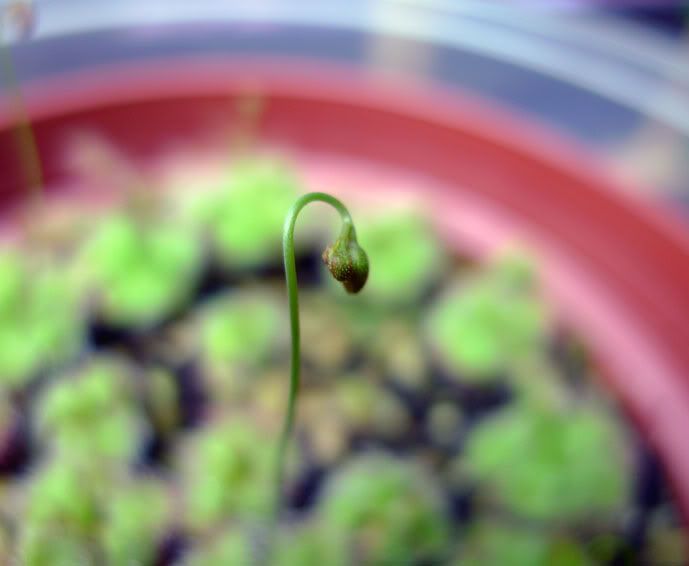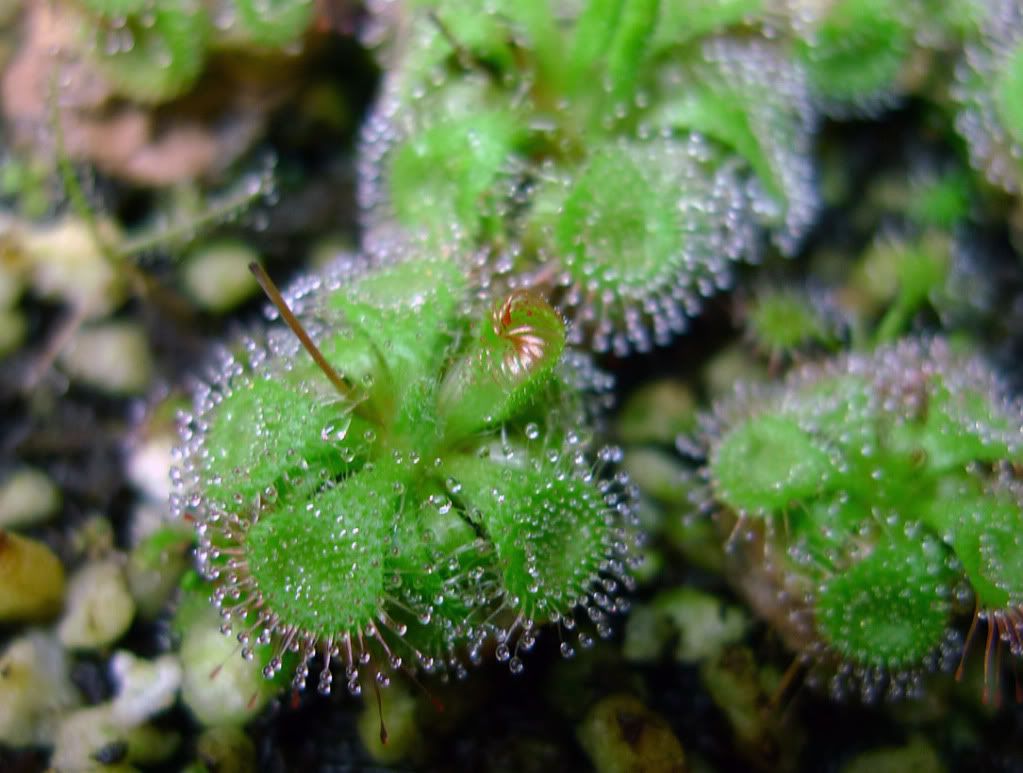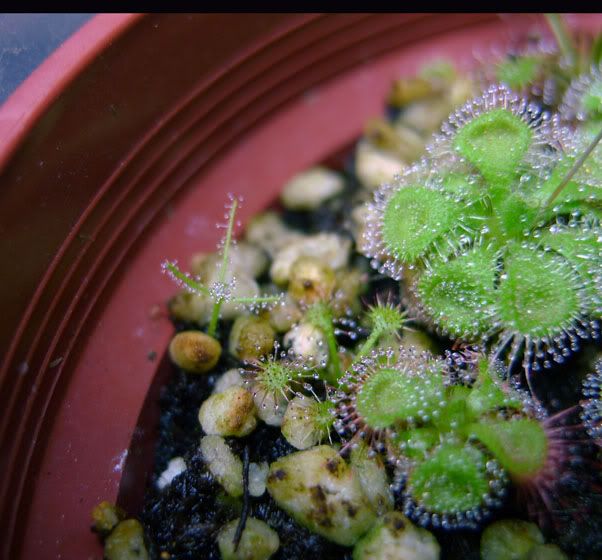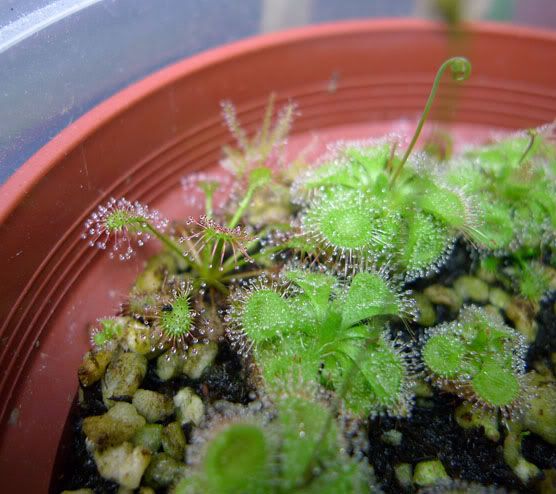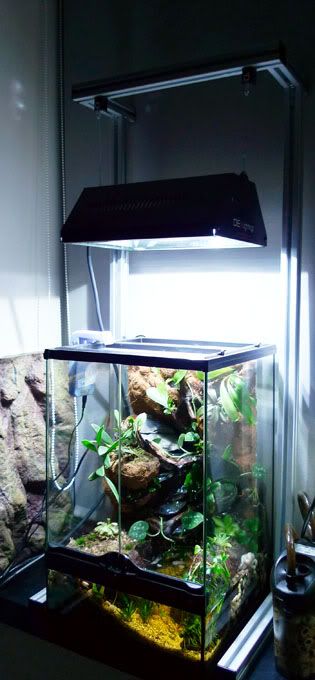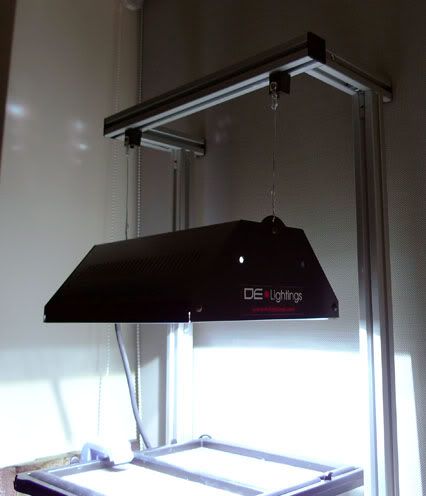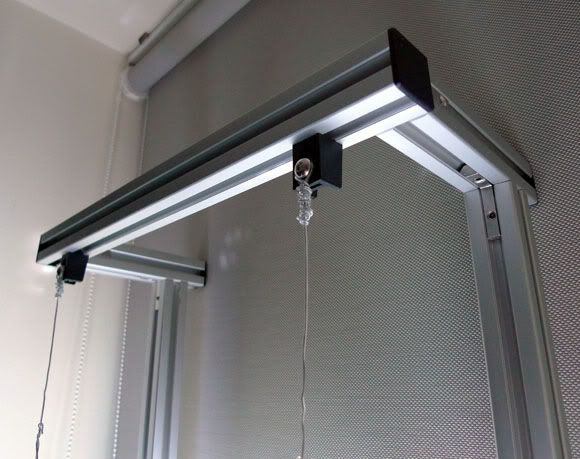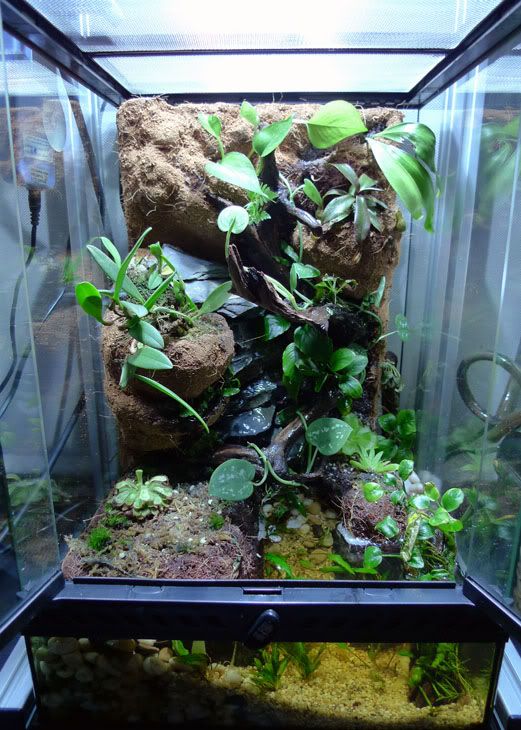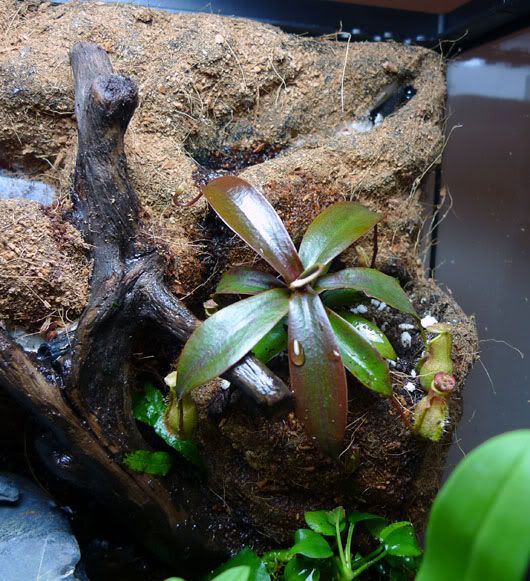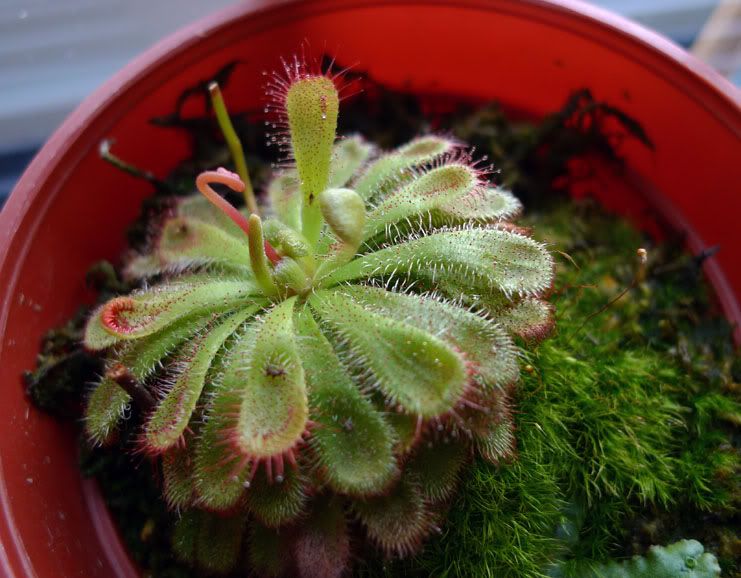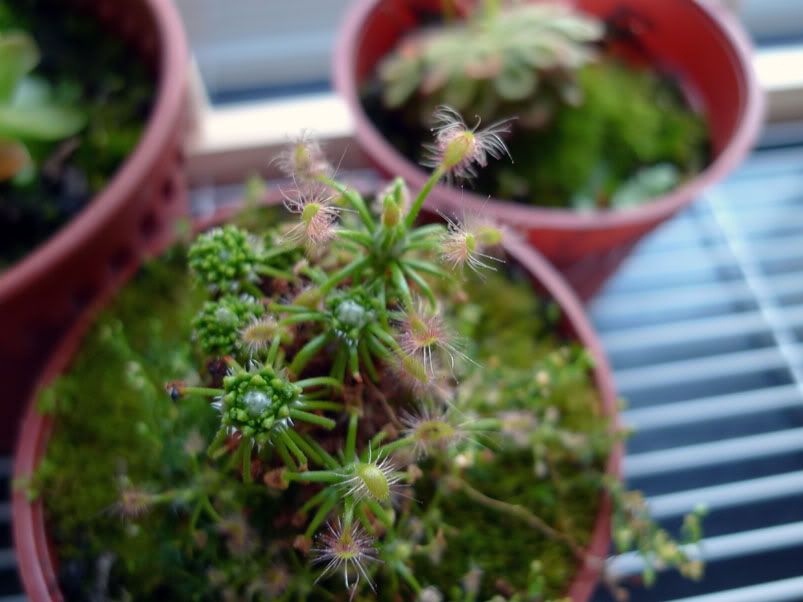Wednesday, May 20, 2009
DIY MH E-ballast cage
The MH E-ballast gets pretty hot while in use and almost got burnt when I accidentally touched it while shifting things around the power point. The cage is constructed from eggcrate (light diffuser) and zipties. Benefit of this cage is that it will prevent accidental touching of the hot e-ballast surface, it is well ventilated with the large holes as well as allowing the eballast to be positioned vertically to allow maximum heat dissipation compared to lying flat.
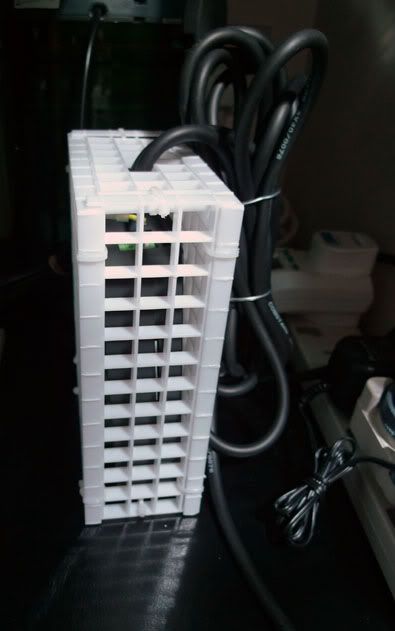

Tuesday, May 12, 2009
ID of the species in the paludarium
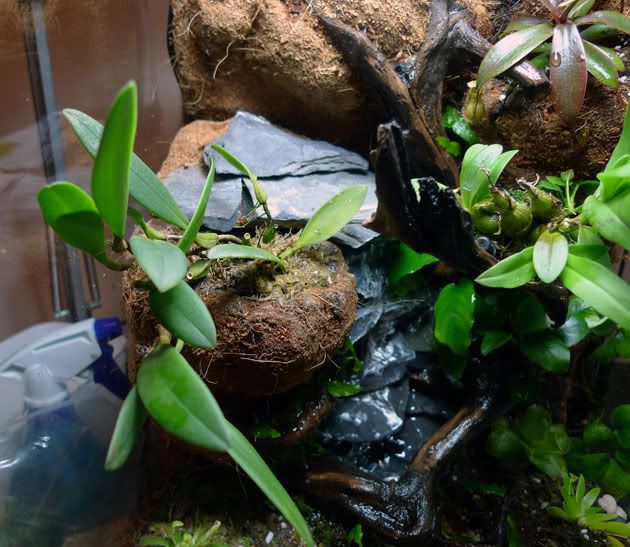 The orchid on the left (next to waterfall) --> Bulbophyllum contortisepalum
The orchid on the left (next to waterfall) --> Bulbophyllum contortisepalum 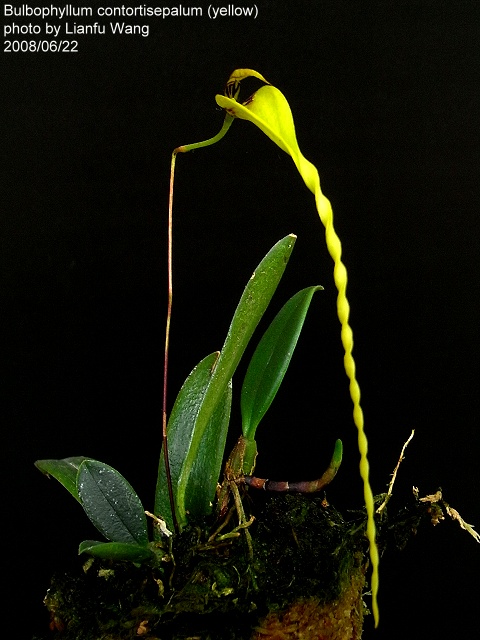 ~~~~~~~~~~~~~~~~~~~~~~~~~~~~~~~~~~~~~~~~~~~~~~~~~~~~~~~~~~~~~~~
~~~~~~~~~~~~~~~~~~~~~~~~~~~~~~~~~~~~~~~~~~~~~~~~~~~~~~~~~~~~~~~  The orchid on the branch --> Dendrobium peguanum
The orchid on the branch --> Dendrobium peguanum  ~~~~~~~~~~~~~~~~~~~~~~~~~~~~~~~~~~~~~~~~~~~~~~~~~~~~~~~~~~~~~~~
~~~~~~~~~~~~~~~~~~~~~~~~~~~~~~~~~~~~~~~~~~~~~~~~~~~~~~~~~~~~~~~ 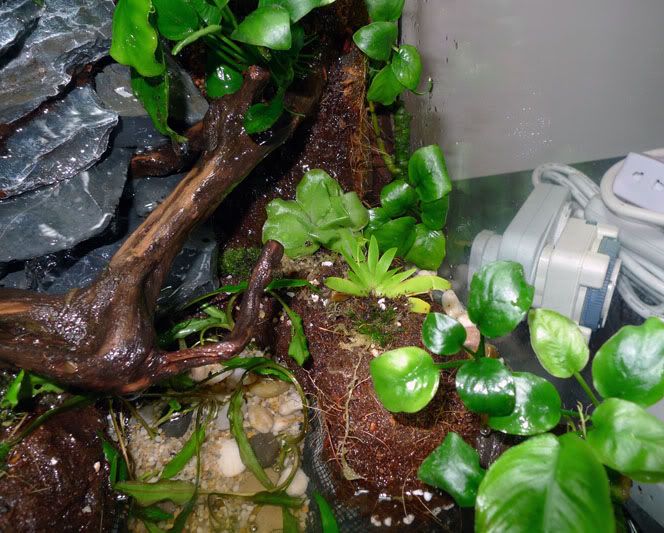 The fan shaped plant on the right --> Psymorchis pussilla
The fan shaped plant on the right --> Psymorchis pussilla  ~~~~~~~~~~~~~~~~~~~~~~~~~~~~~~~~~~~~~~~~~~~~~~~~~~~~~~~~~~~~~~~~~~
~~~~~~~~~~~~~~~~~~~~~~~~~~~~~~~~~~~~~~~~~~~~~~~~~~~~~~~~~~~~~~~~~~ ~~~~~~~~~~~~~~~~~~~~~~~~~~~~~~~~~~~~~~~~~~~~~~~~~~~~~~~~~~~~~~~~
Monday, May 11, 2009
Setting up and planting begins!
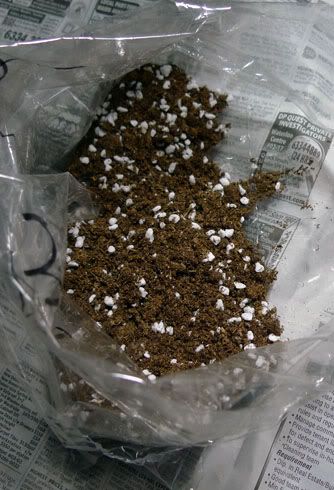 Peatmoss and perlite mix.
Peatmoss and perlite mix. Sphagnum moss and perlite mix.
Sphagnum moss and perlite mix.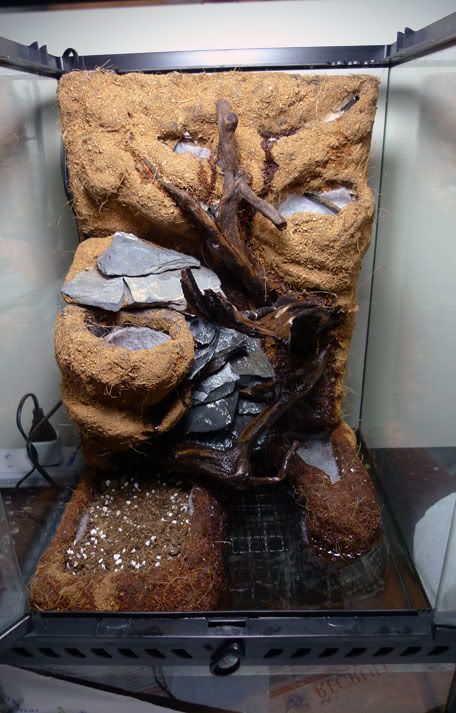
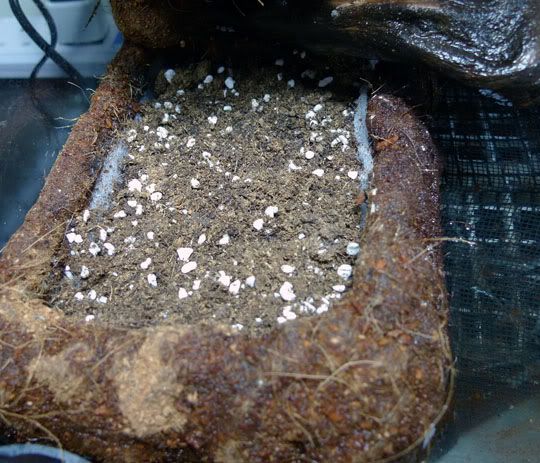 The first layer of peatmoss and perlite mix at the bottom.
The first layer of peatmoss and perlite mix at the bottom.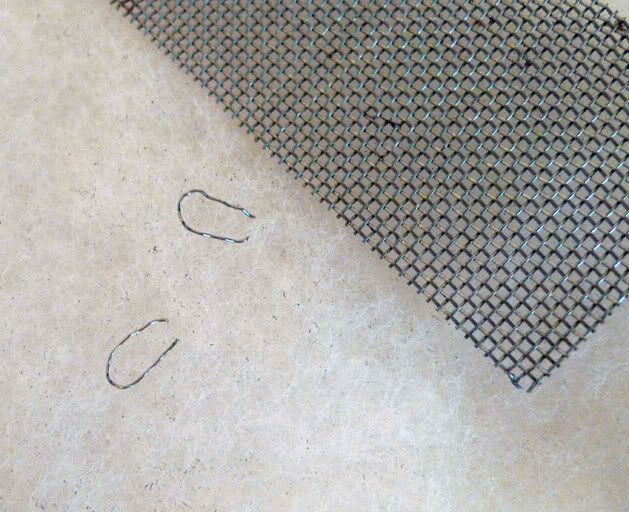 DIY my own anchoring hooks for the plants onto the expanded foam area. I avoided the normal wires as they will rust. So I took an old used stainless steel mesh formerly used to tie moss, took a clamping plier and pulled strands from the edges, cut and bent to shape. Due to the still wavy shape of the wire, it is just perfect to enhance the grip in the foam compared to a straight wire.
DIY my own anchoring hooks for the plants onto the expanded foam area. I avoided the normal wires as they will rust. So I took an old used stainless steel mesh formerly used to tie moss, took a clamping plier and pulled strands from the edges, cut and bent to shape. Due to the still wavy shape of the wire, it is just perfect to enhance the grip in the foam compared to a straight wire.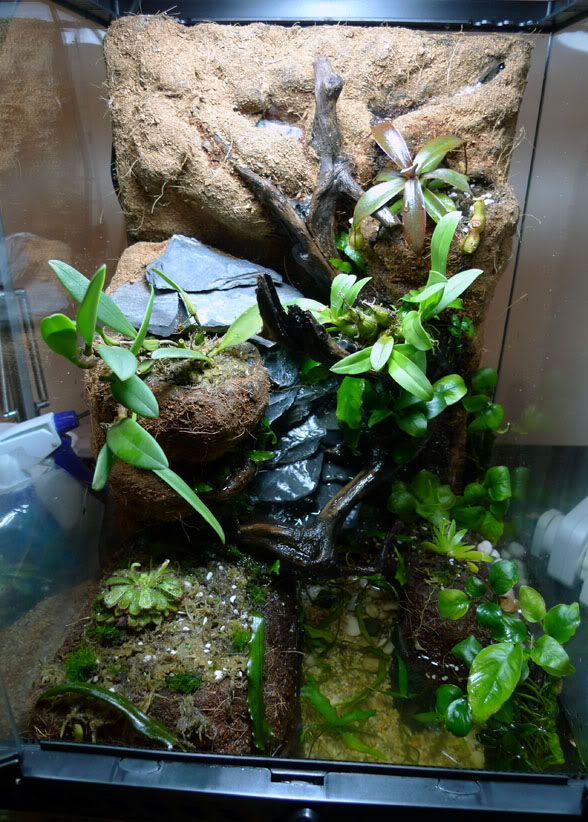 Finally planted...80% intended flora and fauna in....left the top ledge plants and some guppies, otos and shrimps.
Finally planted...80% intended flora and fauna in....left the top ledge plants and some guppies, otos and shrimps. Full tank shot.
Full tank shot.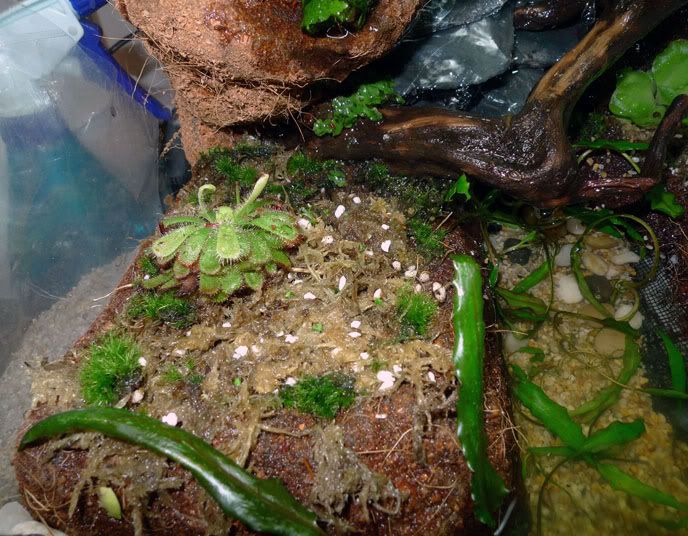 Left front waterlogged area with sundews planted. Added some nice looking moss and hopefully they will lawn over.
Left front waterlogged area with sundews planted. Added some nice looking moss and hopefully they will lawn over. Right front waterlogged area with ping and mini orchid planted. Crypts in the water and water line. Nanas dotted the scape occupying areas wet with dripping water.
Right front waterlogged area with ping and mini orchid planted. Crypts in the water and water line. Nanas dotted the scape occupying areas wet with dripping water. Orchid spp over the left ledge just next to the waterfall.
Orchid spp over the left ledge just next to the waterfall. Another orchid spp. tied to the wooden branch and nep bellii in the right upper ledge.
Another orchid spp. tied to the wooden branch and nep bellii in the right upper ledge. Hoping to fill the left upper ledge with a bromelaide spp. as well as collect some ferns to stuff the moist nooks and crevices.
Hoping to fill the left upper ledge with a bromelaide spp. as well as collect some ferns to stuff the moist nooks and crevices.
Final touchup before setting up and planting starts
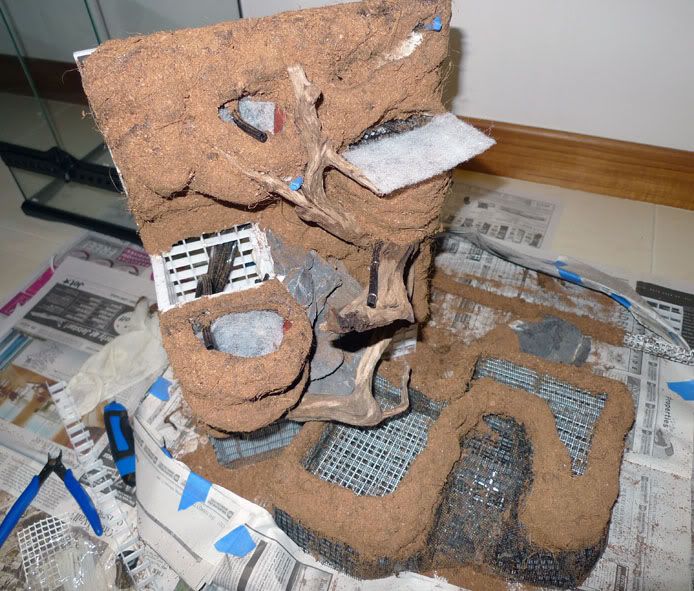 After the black silicon is cured, remove the 3M painter's tape. I had to touch up some areas I missed the first time round as well as the bits that the edge of the blue tape tore out when it was removed.
After the black silicon is cured, remove the 3M painter's tape. I had to touch up some areas I missed the first time round as well as the bits that the edge of the blue tape tore out when it was removed.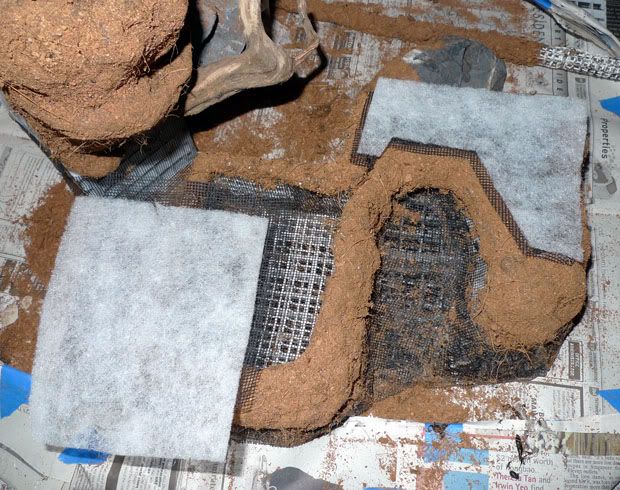 Fine mesh with thin layer of filter wool cut to shape to be laid underneath the peatmoss/sphagnum layer. This will prevent the finer bits to fall through and clog up the water pump prematurely.
Fine mesh with thin layer of filter wool cut to shape to be laid underneath the peatmoss/sphagnum layer. This will prevent the finer bits to fall through and clog up the water pump prematurely.
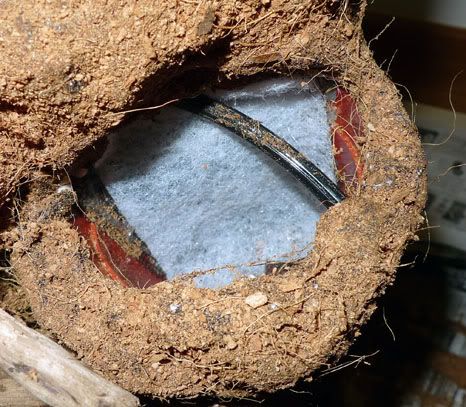 The rear of each suspended pots are lined similarly towards the back where the water is expected to drain.
The rear of each suspended pots are lined similarly towards the back where the water is expected to drain.
Friday, May 8, 2009
The construction
The background and the land area are constructed in 2 separate parts using eggcrate and zip ties. The reason for constructing in 2 separate parts is so that it can fit into the glass terrarium. The pump is located in the left lower back in a chute for easy maintenance access. the plastic pots are meant for deep rooted plants requiring good drainage such as neps, orchids, bromeliades. The plastic pots have drainage to the rear via the eggcrate. The black air tubes are the water drip distribution system routed to each pot and to some strategic points in the scape to let some water drip freely. 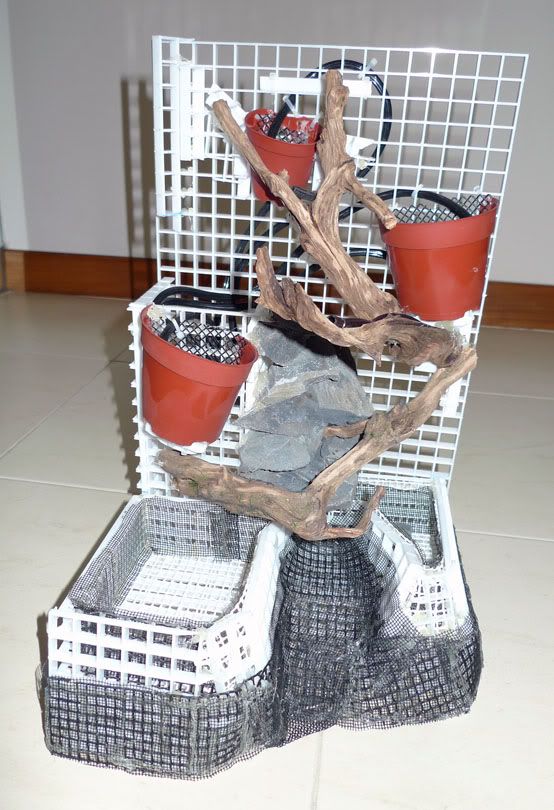
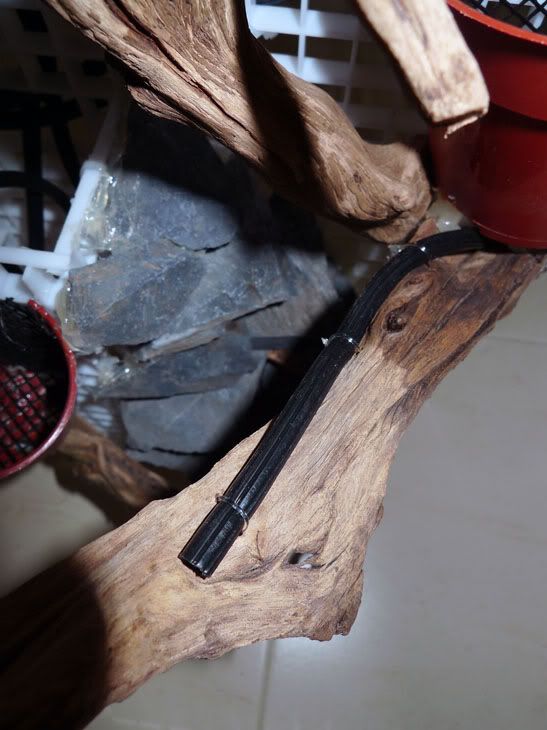 Water drip hose tied to one of the branches. Intending to put some anubias and cover with moss.
Water drip hose tied to one of the branches. Intending to put some anubias and cover with moss.
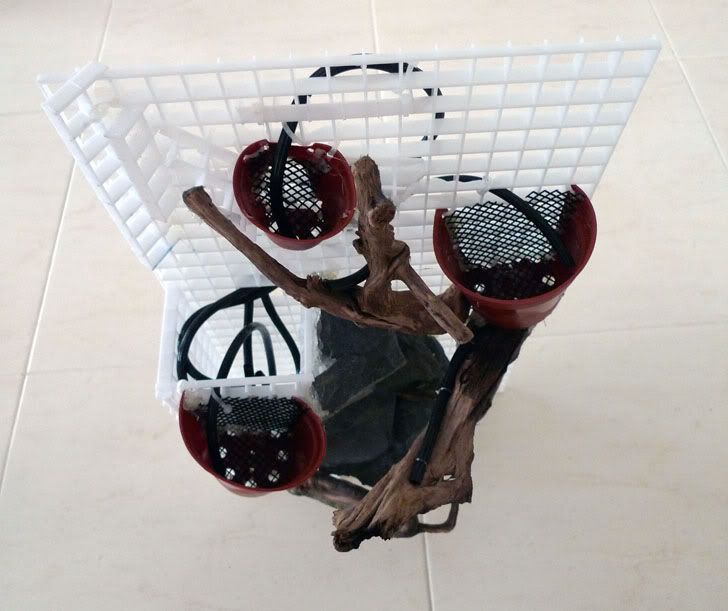 Top view with better appreciation of the water pump chute and the water distribution system.
Top view with better appreciation of the water pump chute and the water distribution system.
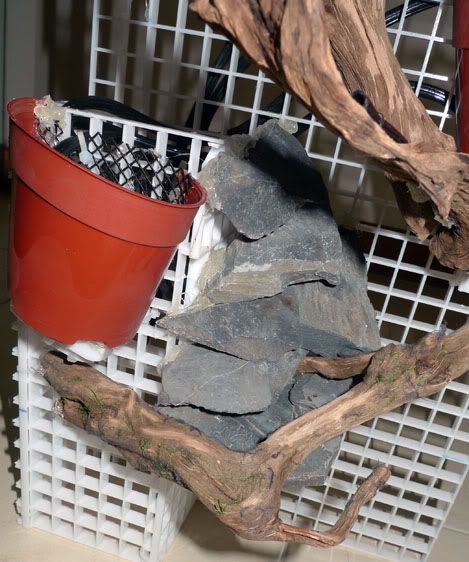 Waterfall constructed from granite slates and epoxy putty.
Waterfall constructed from granite slates and epoxy putty.
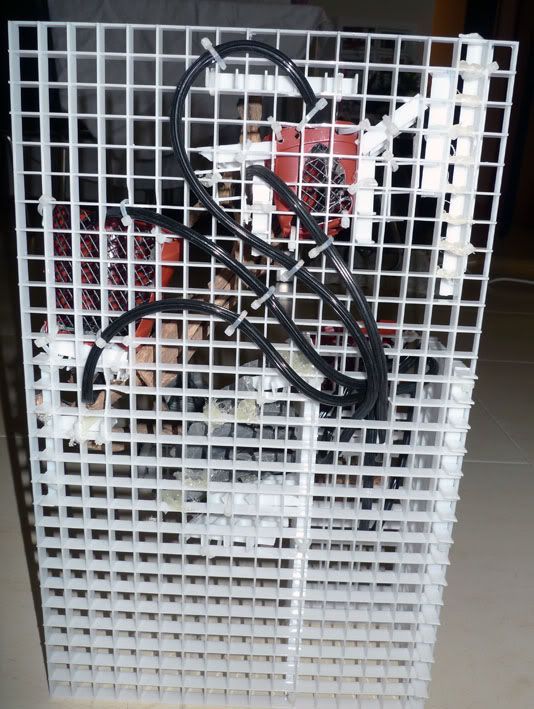 Rear view of the background.
Rear view of the background.
 Sprayed with expanding foam. Very messy to work with. It really expands to 3 times the original amount. Good idea to use disposable gloves!
Sprayed with expanding foam. Very messy to work with. It really expands to 3 times the original amount. Good idea to use disposable gloves!

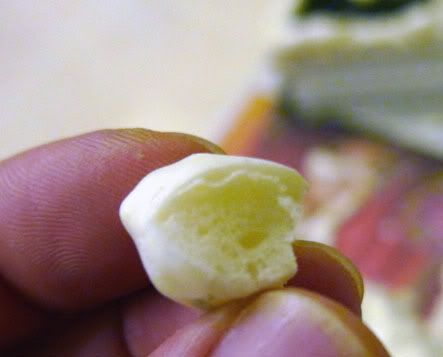 The cut surface of the foam after curing.
The cut surface of the foam after curing.
 The stone and wooden features are wrapped using 3M painter's tape to prevent the silicon sealant from getting onto them. The black silicon silicon is bought from a tank maker who used it for aquariums, so should be safe for the terrarium. Apply the black silicon in small parts as it will start to film over in minutes. tip: wear a pair of disposable gloves, use your right hand to hold the silicon gun and apply to the surface. Use your left hand to smear and spread the silicon evenly onto the surfaces. Once surface ready, put down your silicon gun and use your right hand to grab a handful of cocofibre and press it down onto the surface. Becareful to avoid touching the silicon with your right hand as you will want it relatively clean for the whole process.
The stone and wooden features are wrapped using 3M painter's tape to prevent the silicon sealant from getting onto them. The black silicon silicon is bought from a tank maker who used it for aquariums, so should be safe for the terrarium. Apply the black silicon in small parts as it will start to film over in minutes. tip: wear a pair of disposable gloves, use your right hand to hold the silicon gun and apply to the surface. Use your left hand to smear and spread the silicon evenly onto the surfaces. Once surface ready, put down your silicon gun and use your right hand to grab a handful of cocofibre and press it down onto the surface. Becareful to avoid touching the silicon with your right hand as you will want it relatively clean for the whole process.
Now wait for the silicon to cure in 2-3 days before touching up any parts you missed out.

 Water drip hose tied to one of the branches. Intending to put some anubias and cover with moss.
Water drip hose tied to one of the branches. Intending to put some anubias and cover with moss. Top view with better appreciation of the water pump chute and the water distribution system.
Top view with better appreciation of the water pump chute and the water distribution system. Waterfall constructed from granite slates and epoxy putty.
Waterfall constructed from granite slates and epoxy putty. Rear view of the background.
Rear view of the background. Sprayed with expanding foam. Very messy to work with. It really expands to 3 times the original amount. Good idea to use disposable gloves!
Sprayed with expanding foam. Very messy to work with. It really expands to 3 times the original amount. Good idea to use disposable gloves!
 The cut surface of the foam after curing.
The cut surface of the foam after curing. The stone and wooden features are wrapped using 3M painter's tape to prevent the silicon sealant from getting onto them. The black silicon silicon is bought from a tank maker who used it for aquariums, so should be safe for the terrarium. Apply the black silicon in small parts as it will start to film over in minutes. tip: wear a pair of disposable gloves, use your right hand to hold the silicon gun and apply to the surface. Use your left hand to smear and spread the silicon evenly onto the surfaces. Once surface ready, put down your silicon gun and use your right hand to grab a handful of cocofibre and press it down onto the surface. Becareful to avoid touching the silicon with your right hand as you will want it relatively clean for the whole process.
The stone and wooden features are wrapped using 3M painter's tape to prevent the silicon sealant from getting onto them. The black silicon silicon is bought from a tank maker who used it for aquariums, so should be safe for the terrarium. Apply the black silicon in small parts as it will start to film over in minutes. tip: wear a pair of disposable gloves, use your right hand to hold the silicon gun and apply to the surface. Use your left hand to smear and spread the silicon evenly onto the surfaces. Once surface ready, put down your silicon gun and use your right hand to grab a handful of cocofibre and press it down onto the surface. Becareful to avoid touching the silicon with your right hand as you will want it relatively clean for the whole process.Now wait for the silicon to cure in 2-3 days before touching up any parts you missed out.
Thursday, May 7, 2009
DIY Water Distribution System Version II
Decided to go a little more high tech using metal air hose control valves, plastic tubing, silicon sealant, drinking water safe epoxy putty.

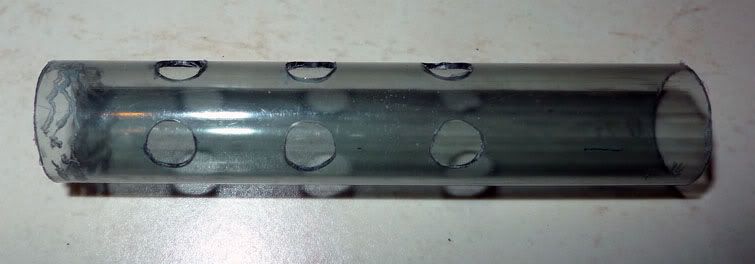
For the plastic tubing, first make some holes (I use Dremel hand tool) for the metal air hose valves along the configuration that you need. Due to space constraint in my application, I opted for 90 degrees angle arrangement. Make your holes just a wee bit smaller than the valve's screw head to allow you to screw the valves in for a snug fit. Notice that I made some scoring lines on the inner surface of one end of the tube? This is to provide a rough surface for the epoxy putty to grip on later on.
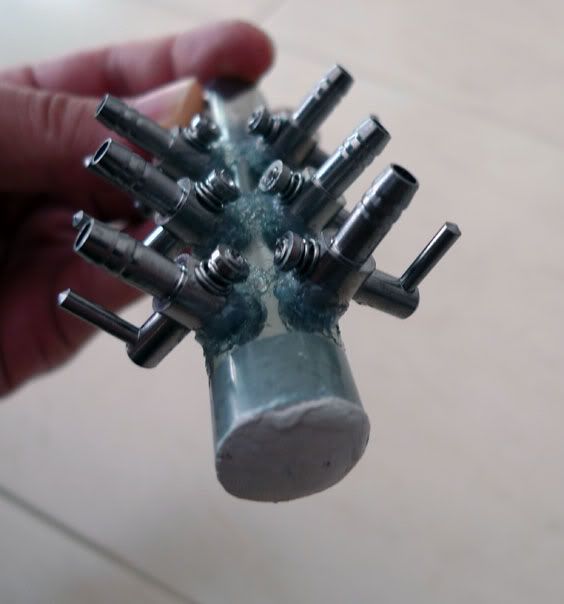
First you need to seal the end of the plastic tubing which you made the scoring lines with a lump of epoxy putty. The reason why you do this first is so that you can push an appropriately sized flat end object (I used a large permanent marker pen) into the tube from the other end to provide counter pressure on the epoxy putty as you push it in from your end. This will create pressure from both ends and resultig in the epoxy putty being pressed firmly into the side of the plastic tubing for a good grip.Without this step, I suspect that the epoxy may not seal the end securely enough.

When you are ready to screw in the valves, only screw in halfway and apply a rim of silicon sealant around the screw threads. After which screw in all the way and apply another layer oof silion sealant around the joint. This will ensure that silicon sealant is within the smallest of the gaps without blocking the water flow passage. Notice the end view of the finished product, the protruding screw threads from the valves will block any attempt to put in any object to provide the counter pressure when applying the epoxy putty.


For the plastic tubing, first make some holes (I use Dremel hand tool) for the metal air hose valves along the configuration that you need. Due to space constraint in my application, I opted for 90 degrees angle arrangement. Make your holes just a wee bit smaller than the valve's screw head to allow you to screw the valves in for a snug fit. Notice that I made some scoring lines on the inner surface of one end of the tube? This is to provide a rough surface for the epoxy putty to grip on later on.

First you need to seal the end of the plastic tubing which you made the scoring lines with a lump of epoxy putty. The reason why you do this first is so that you can push an appropriately sized flat end object (I used a large permanent marker pen) into the tube from the other end to provide counter pressure on the epoxy putty as you push it in from your end. This will create pressure from both ends and resultig in the epoxy putty being pressed firmly into the side of the plastic tubing for a good grip.Without this step, I suspect that the epoxy may not seal the end securely enough.

When you are ready to screw in the valves, only screw in halfway and apply a rim of silicon sealant around the screw threads. After which screw in all the way and apply another layer oof silion sealant around the joint. This will ensure that silicon sealant is within the smallest of the gaps without blocking the water flow passage. Notice the end view of the finished product, the protruding screw threads from the valves will block any attempt to put in any object to provide the counter pressure when applying the epoxy putty.
Subscribe to:
Posts (Atom)
